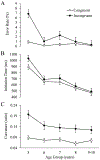Reach tracking reveals dissociable processes underlying inhibitory control in 5- to 10-year-olds and adults
- PMID: 28233397
- PMCID: PMC6204061
- DOI: 10.1111/desc.12523
Reach tracking reveals dissociable processes underlying inhibitory control in 5- to 10-year-olds and adults
Abstract
Researchers have proposed that two processes featuring distinct types of inhibition support inhibitory control: a response threshold adjustment process involving the global inhibition of motor output and a conflict resolution process involving competitive inhibition among co-active response alternatives. To target the development of these processes, we measured the reaching behavior of 5- to 10-year-olds (Experiment 1) and adults (Experiment 2) as they performed an Eriksen flanker task. This method provided two key measures: initiation time (the time elapsed between stimulus onset and movement onset) and reach curvature (the degree to which a movement deviates from a direct path to the selected target). We suggest that initiation time reflects the response threshold adjustment process by indexing the degree of motoric stopping experienced before a movement is started, while reach curvature reflects the conflict resolution process by indexing the degree of co-activation between response alternatives over the course of a movement. Our results support this claim, revealing different patterns effects in initiation time and curvature, and divergent developmental trajectories between childhood and adulthood. These findings provide behavioral evidence for the dissociation between global and competitive inhibition, and offer new insight into the development of inhibitory control.
© 2017 John Wiley & Sons Ltd.
Figures








Similar articles
-
Layers of latent effects in cognitive control: An EEG investigation.Acta Psychol (Amst). 2019 Apr;195:1-11. doi: 10.1016/j.actpsy.2019.02.004. Epub 2019 Mar 1. Acta Psychol (Amst). 2019. PMID: 30831386 Free PMC article.
-
Reach tracking reveals dissociable processes underlying cognitive control.Cognition. 2016 Jul;152:114-126. doi: 10.1016/j.cognition.2016.03.015. Epub 2016 Apr 2. Cognition. 2016. PMID: 27045465 Free PMC article.
-
Cognitive control in action: Tracking the dynamics of rule switching in 5- to 8-year-olds and adults.Cognition. 2017 Jul;164:163-173. doi: 10.1016/j.cognition.2017.03.023. Epub 2017 Apr 18. Cognition. 2017. PMID: 28431279 Free PMC article.
-
Physiological evidence for response inhibition in choice reaction time tasks.Brain Cogn. 2004 Nov;56(2):153-64. doi: 10.1016/j.bandc.2004.06.004. Brain Cogn. 2004. PMID: 15518932 Review.
-
Dynamic field theory of movement preparation.Psychol Rev. 2002 Jul;109(3):545-72. doi: 10.1037/0033-295x.109.3.545. Psychol Rev. 2002. PMID: 12088245 Review.
Cited by
-
Moving beyond response times with accessible measures of manual dynamics.Sci Rep. 2022 Nov 9;12(1):19065. doi: 10.1038/s41598-022-20579-9. Sci Rep. 2022. PMID: 36351962 Free PMC article.
-
The Relationships Among Testosterone, Cortisol, and Cognitive Control of Emotion as Underlying Mechanisms of Emotional Intelligence of 10- to 11-Year-Old Children.Front Behav Neurosci. 2019 Dec 17;13:273. doi: 10.3389/fnbeh.2019.00273. eCollection 2019. Front Behav Neurosci. 2019. PMID: 31920581 Free PMC article.
-
Design choices: Empirical recommendations for designing two-dimensional finger-tracking experiments.Behav Res Methods. 2020 Dec;52(6):2394-2416. doi: 10.3758/s13428-020-01409-0. Behav Res Methods. 2020. PMID: 32415558 Free PMC article.
-
Layers of latent effects in cognitive control: An EEG investigation.Acta Psychol (Amst). 2019 Apr;195:1-11. doi: 10.1016/j.actpsy.2019.02.004. Epub 2019 Mar 1. Acta Psychol (Amst). 2019. PMID: 30831386 Free PMC article.
-
The influence of reward anticipation on conflict control in children and adolescents: Evidences from hierarchical drift-diffusion model and event-related potentials.Dev Cogn Neurosci. 2022 Jun;55:101118. doi: 10.1016/j.dcn.2022.101118. Epub 2022 May 24. Dev Cogn Neurosci. 2022. PMID: 35653919 Free PMC article.
References
-
- Anderson SE, Farmer TA, Goldstein M, Schwade J, & Spivey M (2011). Individual differences in measures of linguistic experience account for variability in the sentence processing skill of five-year-olds. Experience, variation, and generalization: Learning a first language (Trends in Language Acquisition Research), 7, 203–221.
-
- Carlson SM, Moses LJ, & Breton C (2002). How specific is the relation between executive function and theory of mind? Contributions of inhibitory control and working memory. Infant and Child Development, 11(2), 73–92. doi: 10.1002/icd.298 - DOI
Publication types
MeSH terms
Grants and funding
LinkOut - more resources
Full Text Sources
Other Literature Sources

